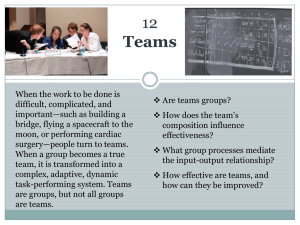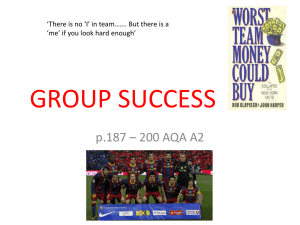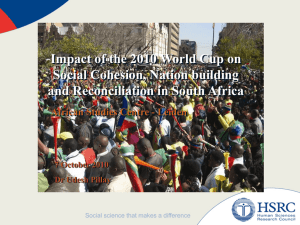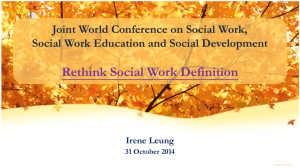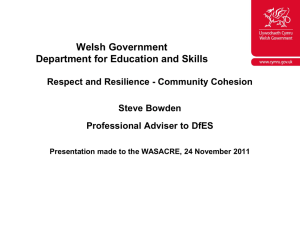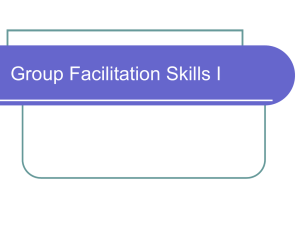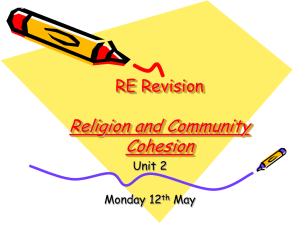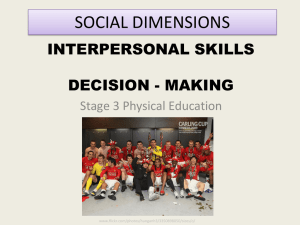P5- Group dynamics and performance in team sports
advertisement
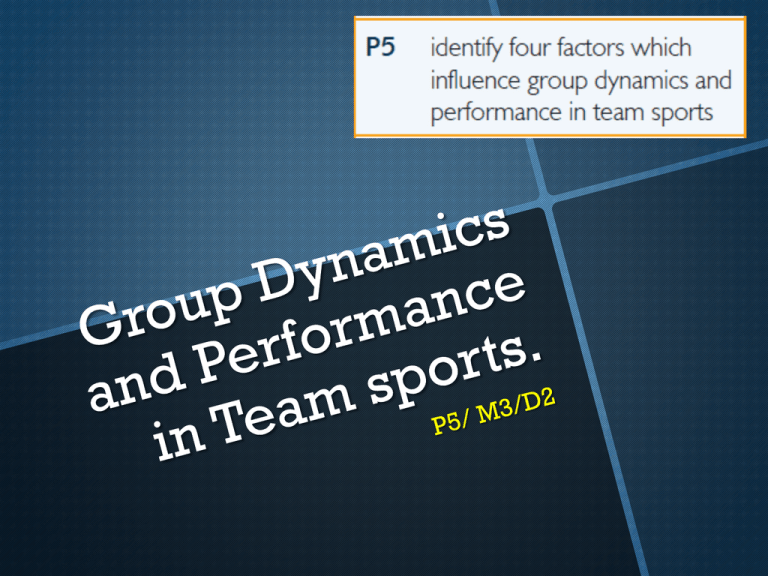
Group: “Two or more persons who are interacting with each other in such a manner that each person influences and is influenced by each other person”. What defines a group? - Interaction between the members. - Positive feelings towards each other. - A collective identity distinctive from other groups. - A sense of shared purpose or objectives Ensure all members understand their own role. Making sure that members accept their role. Acknowledging informal roles where they are helpful to the group and dealing with unhelpful informal roles (e.g. troublemakers) Team: “A good team is more than a group of skilled players; members need to work together effectively to be successful. Steiner (1972)”. What examples can you think of to back this up??? - Football, Ryder Cup, Lions Task Using the paper as stepping stones: Get across the room without falling into the water”. If you step off any paper it will float off down the river. Group Development Becoming a team is a process… Tuckman and Jensen (1977): Forming Group Comes together Storming Period of conflict as roles and status within group are tested Norming As conflict subsides, cooperation to common goals Performing Group works together to achieve mutual goals. Relationships are established. New members to group undergo the same process How did the task reflect that process??? How do we know this is a group? Give examples of the roles in this team (formal and informal). How can they make this group more effective? Which stage would this group be in? Group effectiveness: Actual productivity = Steiner (1979) Actual Productivity= The actual performance Potential productivity= The best possible performance achievable based on group resources (ability/knowledge/skill) Process loses= Due to working as part of a group (loss in motivation/ lack of communication/ loss of confidence/ reliance on other players etc) Potential productivity – losses due to faulty group processes. EG: Tug of war team: - Individually they can pull 100kg each, yet as a team of 4 they can only pull 360kg in total… why? What can coaches do???? - Need to improve skill level and performance of players whilst reducing the faulty processes mentioned before. But HOW can they do that??? Clarify roles, better tactics, selection of players, improve fitness… Ringlemann Effect: Tendency for individuals to lessen their effort when pat of a group. Tug of war experiment= More men pulling, the less effort each individual put in. SOCIAL LOAFING When in groups performers are motivated to work, yet save their best performance when under scrutiny/ alone. What is Cohesion?? Find a definition… Task Cohesion: The degree to which group members work together and are committed to reaching common goals. The degree to which group members like each other and get on. Social Cohesion: More positive relationship between task cohesion and performance than between social cohesion and performance Factors that affect Cohesion: (Type of sport) – cohesion facilitates in interactive sports eg team sports; (Stability) – more stable gives more time for cohesion to develop; (Group size) – smaller groups have greater cohesion because of more interaction; (External threats) – increase cohesion by forcing members to ignore internal divisions; (Status) similarity of status/age/ability aids cohesion; Satisfaction with rest of group aids cohesion; Group success increases cohesiveness” Cohesion and Team performance: One of the defining features of a group is that its members have common beliefs. As the group develops so do these norms which members of the group are committed to. If a group is to be successful Those who challenge the norms there needs to be an element of success. It has been suggested that cohesion develops as a direct result of success. It is assumed the more cohesive a group, the better the chance of victory. also challenge the group’s solidarity; hence groups exert pressure on their members to conform to these norms. The leader of the group’s role is to set and maintain these norms. TASK… 1. Were you a group or a team? 2. What skills did you have to use in order to achieve the task aim? 3. HUMAN KNOTS… In teams of 6-8, each team forms a small circle. Ask them to extend their right hand across the circle and hold the left hand of the other team member opposite them. Then extend their left hand across the circle and hold the right hand of another group member. The task is to unravel the spider's web of interlocking arms without letting go of anyone's hands “Behavioural process of influencing individuals and groups towards goals” Barron, 1977 Leaders determine how a task is completed… How is their role different from managers? Leaders… PRESCRIBED leaders… Are appointed by a person of authrority, for example a chairman appointing a manager or manager appointing a coach. EMERGENT leaders… Emerge from a group and take over responsibility, for example John Terry becoming the England captain or Chris Robshaw being the England rugby captain. How would both of these differ in terms of how the captain is received by his team mates?? Theories: To help understand effective leadership… • Trait Approach • Behavioural Approach • Interactional Approach Born/ predisposed A person who is a good leader in one to leader situation is a good leader in all personality situations traits • What stable and Trait Approach: common personality traits can you think of, that leaders must have? Behavioural Approach: Learn leadership behaviours from other effective leaders. Interactional Approach: - Can predict leaders on personality - Leadership is dependent on certain situations, as some function better in certain situations - Leadership styles change to suit the situation Multidimensional model of sport leadership: If the leader behaves appropriately for the particular situation and such behaviour matches the group personalities… this will result in their best performance. Modern theories from Chelladurai and Saleh (1980) suggest that effective leadership vary depending on: CHARACTERISTICS of the ATHLETES, the LEADER and SITUATION. Different Leadership styles: Different leaders find different styles successful in one situation and not in another… Democratic Behaviour: - Athlete is involved in the decisions regarding the group goals/ strategies Autocratic Behaviour: - Coach/ leader forces decisions o the group independently Social Support Behaviour: - Developing group relationships, in order to improve well being of the group Positive Feedback Behaviour: - Rewarding individual and group actions through acknowledgement of effort and performance For P5, learners must identify four factors which influence group dynamics and performance in team sports. This should include aspects of group processes, cohesion and leadership. This could be based on the observation of a game or match; learners could observe the changes in behaviour due to changes in the situation. P5: Group processes (e.g groups or teams, stages of group development and theories regarding group effectiveness) Cohesion (e.g task and social team climate and factors cohesion) cohesion, effecting Leadership (e.g qualities and behaviour, prescribedversus emergent leaders, and theories of leadership) For M3, which links to P5, learners must explain the four factors which influence group dynamics and performance in team sports. Analysing the positive and negative factors on performance


